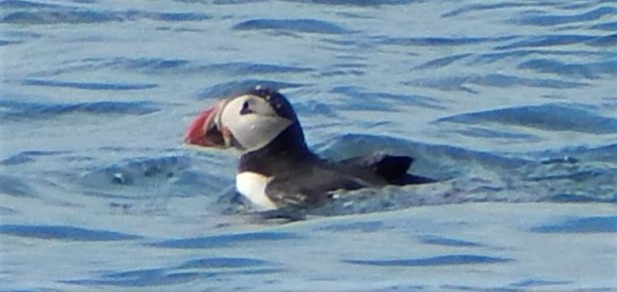
[149] Fratercula arctica, Puffin
Introduction
Fratercula arctica, the Puffin, is a seabird that develops an impressive coloured bill in its breeding form. Together with its relatives the Guillemot, Razorbill and Black Guillemot it is only found in remote parts of the UK when it visits to breed. There are two species of Fratercula found in the Pacific, so the formal name Atlantic Puffin may be used for Fratercula arctica.
It should not, of course, be confused with the Manx Shearwater, Puffinus puffinus.
Taxonomy
Kingdom – Animals
Phylum – Chordates
Class – Aves (Birds)
Order – Charadriformes (Sea Birds and Waders)
Suborder – Lari (Gulls, Terns, Auks, Skuas and others)
Clade – Alcoidea
Family – Alcidae (Auks including Guillemots, Murres)
Subfamily – Fraterculinae (Puffins and Auklets)
Tribe – Fraterculini (Puffins)
Genus – Fratercula
Scientific Name – Fratercula arctica
Names
Puffin was originally the name of the Manx Shearwater, which has been given the Scientific Name Puffinus puffinus. It meant puffed or swollen for the fatty, salted meat from young birds. The name transferred much later, possibly because of similar nesting habits, to the bird we now call a Puffin. Fratercula is Medieval Latin for a friar from its black and white plumage resembling monastic robes.
See text for some notes on the etymology of other birds in the Auk family.
Sea Birds
It won’t come as a surprise that there is no agreed definition of what constitutes a Sea Bird but the term can be used for birds that more or less spend their lives at sea and feed in saltwater. It normally includes the following.
- Sphenisciformes, Penguins.
- Procellariformes, Albatrosses, Shearwaters and Petrels.
- Suiformes, Gannets and some relatives but not Cormorants.
- Charadriformes, Skuas, Gulls, Terns and Auks but not waders.
Phalaropes, Divers (Loons in USA terminology,) Grebes, sea ducks, waders and Herons are normally considered to be water birds but not sea birds.
We have already met [080] Black-headed Gull, and will come later to see [195] Herring Gull, [196] Lesser Black-backed Gull, and [325] the Common Tern, all of which spend some or all of their life far from the sea in Britain.
Most true sea birds only just touch the UK when they have to land for breeding purposes.
Auks (Alcidae)
Birds in the Auk family are in some ways similar to Penguins. They are so good at swimming that they almost fly underwater. They have little need to fly and are clumsy when trying to walk on land. But they don’t have to walk. They generally nest on cliffs.
The Auk family, Alcidae, is quite small but has several levels of taxonomy. Its species have several names, generally differing between the UK and the USA. Auk, via Icelandic from Old Norse means a sea bird.
The Tribe Alcini, calles Murres in the US, include what we call the Guillemot and Razorbill.
The Tribe Cepphini, called True Guillemots in the USA, includes the Black Guillemot.
Some, like Puffins, dig burrows on the cliff top. Most of them, like Guillemots, just lay an egg on a bare rock ledge without a nest.
See below for details of some other Auk species.
Puffin
The Puffin basically spends its life at sea and feeds by diving and swimming underwater. Male and female birds look identical with a slight difference in size. We know them for their large unusually shaped black, white and orange bills, but these only appear in the mating season. The colourful outer part drops off after breeding when the birds return to the sea.
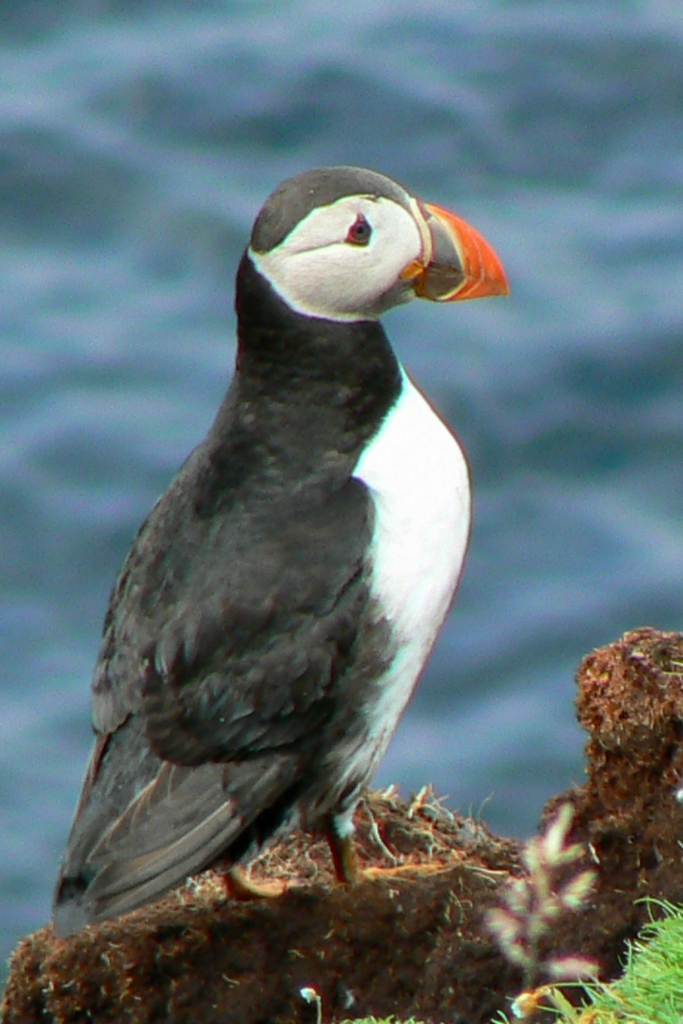
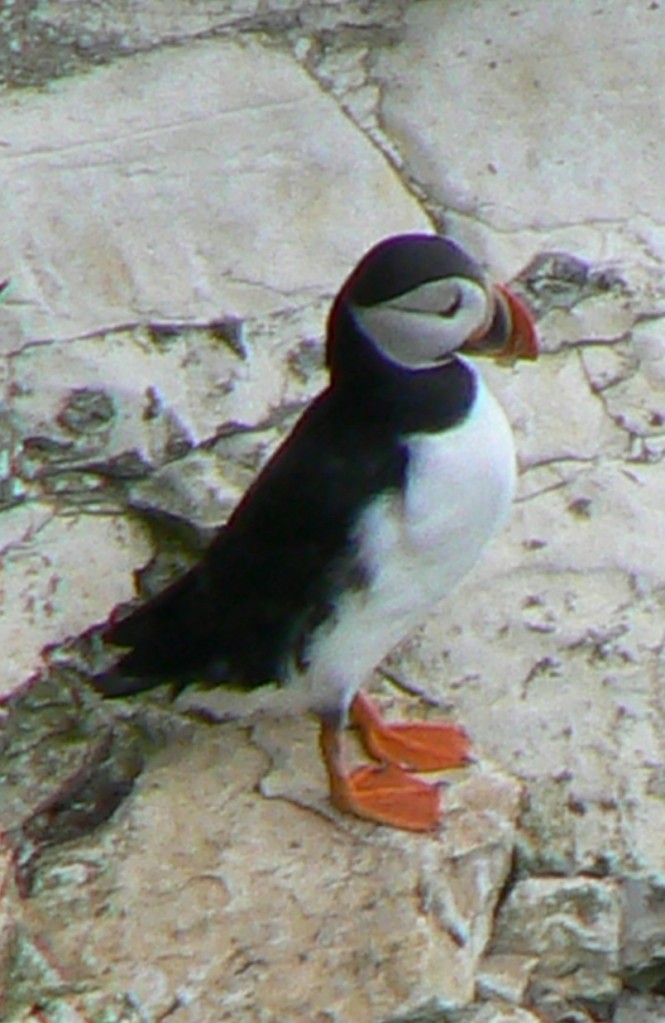

It breeds on the Atlantic coasts of Norway, Iceland, the Faroe Islands, Greenland, Canada, and parts of Britain. Most of the locations it vits in the UK are Scottish islands but they are also found on the Farne Islands, Northumberland; Bempton Cliffs, Yorkshire; Skomer Island in Wales and the Scillies.
I was lucky enough to visit Fair Isle (midway between Orkney and mainland Shetland) for very close views of Puffin,
In clifftop colonies it digs a burrow and lays a single egg. Both adults catch sand eels to feed to their chicks and they are able to carry large numbers in their beaks at the same time.
When the chicks fledge, they make their way to the sea by night and will not return to land for several years.
They have historically been a source of food in some isolated parts of Iceland and the Faroe Islands. I am not sure if this continues.
Guillemot and Razorbill
These two are very similar black and white sea birds without the spectacular bill of the Puffin. They lay their eggs on cliff edges rather than in burrows. There is no actual nest and the eggs have a sort of conical shape so they do not roll off the edge.
Uria aalge is the (Common) Guillemot (UK) or Common Murre (US), also called the Thin-billed Murre. It has a long, pointed bill. Guillemot comes from a French form of the name William. Uria comes from the Ancient Greek ouriaa, an unknown waterbird. The Danish aalge is cognate with auk. Murre is of unknown origin but may be onomatopoeic.
Alca torda is the Razorbill or lesser Auk. Its large, flat bill is distinct and gives it its name. Auk and Alca both come from the Norwegian alke, and torda comes from tӧrd a Swedish dialect word. Both words refer to this species.
Both birds are gregarious and breed together. They can be seen at Bempton Cliffs in Yorkshire, where Guillemots vastly outnumber Razorbills. You are unlikely to get near to them but may discern which is which with good binoculars.
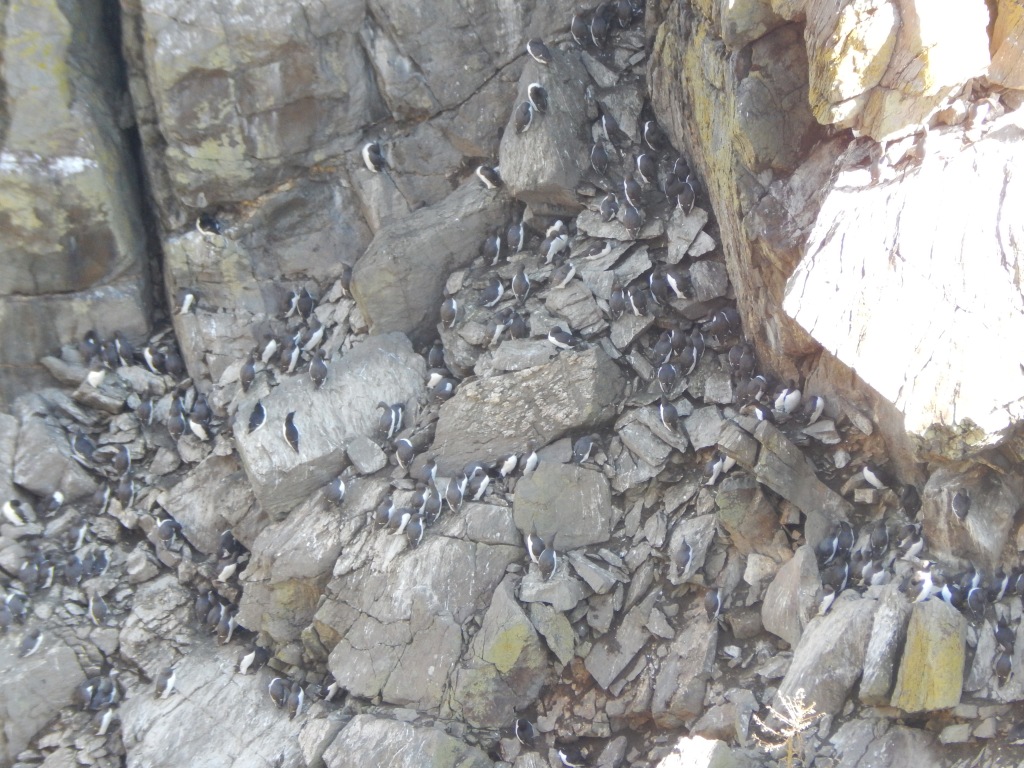

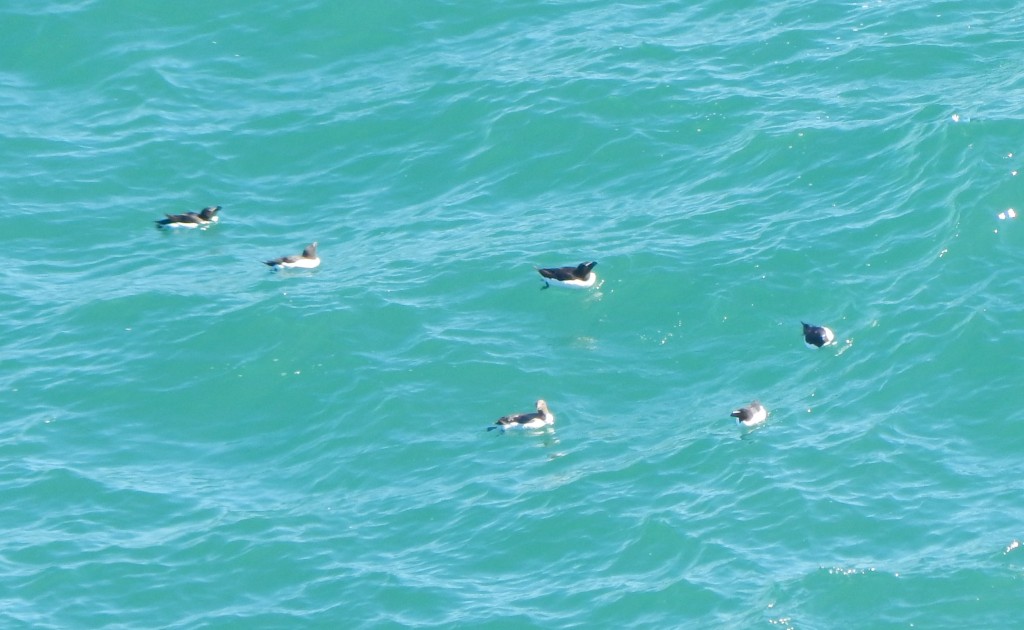
Black Guillemot
The UK distribution of Cepphus grylle, the Black Guillemot, is different and it is found mostly along the west coast of Scotland around rocky islets. It is also found on the Isle of Man and the island of Anglesey. I have seen them in Ayr harbour.
Cepphus comes from Ancient Greek kepphos, a pale waterbird mentioned by Aristotle and others. Grylle was a local dialect name for the bird in Gotland.
They are not gregarious like Guillemots and Razorbills and will spend the winter quite near to their summer breeding locations.
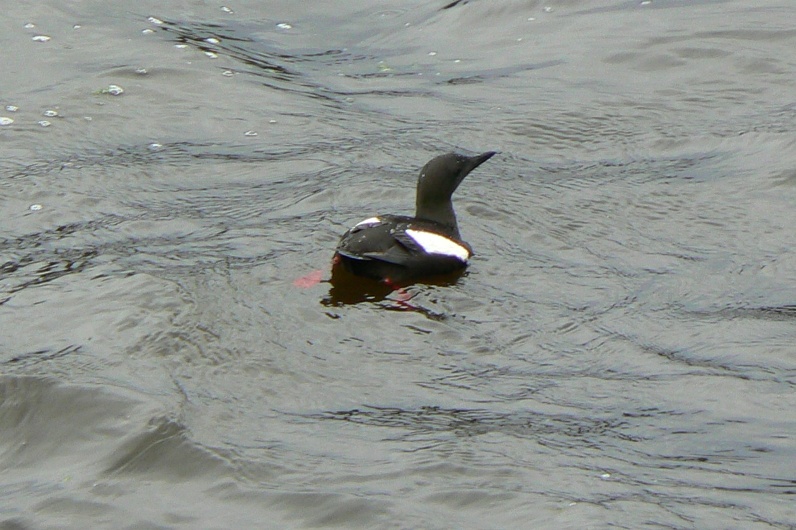

See Also
While you are in isolated island or cliff environments look out for these.
- [230] Gannet.
- Shag, Phalacrocorax aristotelis, a smaller much more sea-going version of the [255] Cormorant.
- Fulmar, Fulmarus glacialis, a tube-nosed Gull-like bird occasionally seen on coastal cliffs.
- Kittiwake, Rissa tridactyla, a marine Gull that occasionally nests on cliffs.
